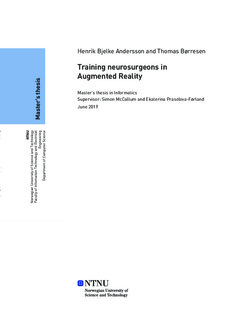Training neurosurgeons in Augmented Reality
Abstract
Målet med denne studien er å se hvordan Augmented Reality kan bli brukt til å trene og læreopp neurologer og neurokirurger i en nylig utviklet prosedyre kalt SPGblock. Prosedyren erutviklet på St. Olavs Universitetssykehus i Trondheim og har som mål å behandle kroniskmigrene og klasehodepine med et nylig utviklet klinisk verktøy kalt Multiguide.SPGblock har vist lovende resultater, og teamet som står bak prosedyren har et ønske om atden skal kunne tilbys flere steder enn bare i Trondheim. Å lære opp leger og kirurger er bådetidkrevende og dyrt. Det er derfor ønskelig å finne bedre løsninger for opplæring av kirurger ogleger i prosedyren.Dette prosjektet vil bygge videre på en tidligere masteroppgave kalt Sphenoblock AR som tilbøden simulering av prosedyren i Microsoft Hololens. Målet med dette prosjektet er å legge til merfunksjonalitet, og å forbedre eksisterende funksjonalitet. De viktigste oppgavene er å legge tilmer anatomi og forbedre sporingen av Multiguiden. Oppgaven vil også ta for seg åsammenligne hvilken av AR brillene, Hololens, Magic Leap On, og Meta 2, som er best egnetfor en SPGblock simulator, og hvem av dem som var mest egnet til å utvikle en slik applikasjonfor.Resultatene viste at applikasjonen fungerer godt for opplæring og demonstrering av SPGblockprosedyren. På den andre siden så mangler den noen aspekter som gjør den mindre nyttig for åtrene på den faktiske prosedyren. De viktigste aspektene som manglet viste seg å være mangelpå taktil tilbakemelding når man utfører prosedyren, samt at anatomien hadde for lavt detaljnivå.Resultatene kom fra observasjoner og brukertester, etterfulgt av intervjuer med neurokirurger ogneurologer på St. Olavs. Videre arbeid burde fokusere på å finne en måte å legge til taktilmotstand under utførelsen av prosedyren, og mer detaljert anatomi for hode. This study aims to see how Augmented Reality can be used to train and teach neurologists andneurosurgeons in a newly developed neurological procedure called SPGblock. The procedure is developed at St. Olavs University Hospital in Trondheim, Norway, and aims to treat chronic migraineand cluster headaches with a newly developed surgical instrument called Multiguide. It has shownpromising results, and the team behind the procedure seeks to offer the procedure to a broaderaudience. Training physicians and surgeons is a time-consuming and expensive exercise. Becauseof this, there is a need for better ways to train and educate new surgeons and physicians in theprocedure. This project will continue the development of a SPGblock training simulator developedfor the Microsoft Hololens. The goal of this project is to add new functionality to the simulator andenhancing the existing functionality. The most necessary functionality to implement being morelayers of anatomy and improving the tracking of the Multiguide. It will also include testing whichof the Hololens, the Magic Leap One and the Meta 2, is most suited for such a simulator and how itwas to develop for.The findings show that the application works great for teaching and demonstrating the SPGblockprocedure. On the other hand, it lacks some aspects in order to be used for training. One of themain aspects being the lack of haptic feedback, the other being that the quality of the anatomy wastoo low. The findings were revealed through observations and user tests, followed by interviewswith neurosurgeons and neurologists at St. Olavs. Further work should look into better ways ofincorporating haptic feedback when performing the procedure, and increasing the level of detail inthe anatomy of the head.
